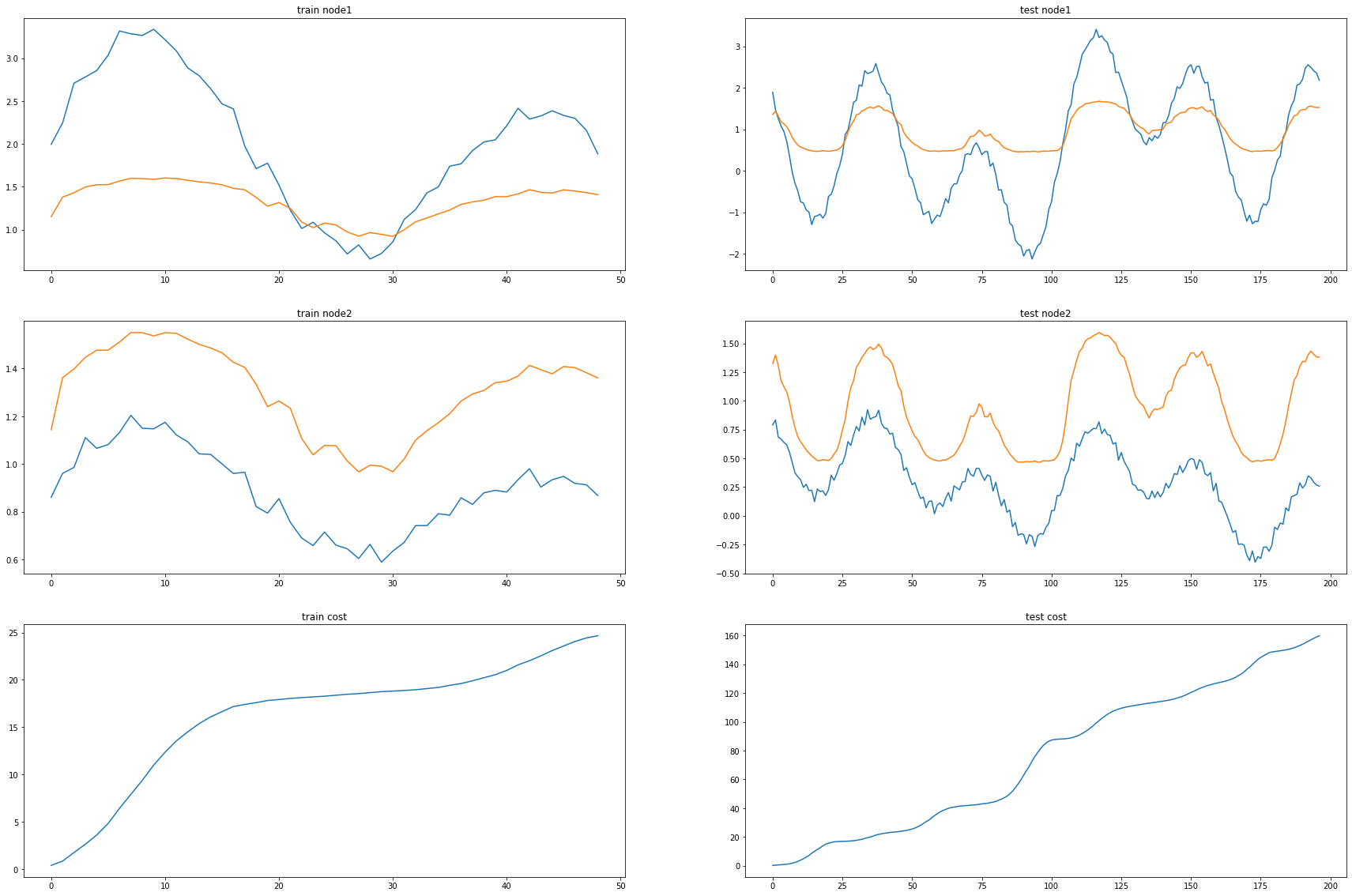import numpy as np
import matplotlib.pyplot as plt
import pandas as pd
import torchPyG Geometric Temporal Examples
PyG
Examples
Refer: https://github.com/benedekrozemberczki/pytorch_geometric_temporal/tree/master/examples/recurrent
T = 250
t = np.arange(T)/T * 5
x = 1*np.sin(2*t)+0.3*np.random.rand(T)+0.5+np.sin(4*t)+1.5*np.sin(8*t)
eps_x = np.random.normal(size=T)*0
y = x.copy()
for i in range(2,T):
y[i] = 0.35*x[i-1] - 0.15*x[i-2] + 0.5*np.cos(0.4*t[i])
eps_y = np.random.normal(size=T)*0
x = x
y = y
plt.plot(t,x,color='C0',lw=5)
plt.plot(t,x+eps_x,alpha=0.5,color='C0')
plt.plot(t,y,color='C1',lw=5)
plt.plot(t,y+eps_y,alpha=0.5,color='C1')
_node_ids = {'node1':0, 'node2':1}
_FX1 = np.stack([x+eps_x,y+eps_y],axis=1).tolist()
_edges1 = torch.tensor([[0,1]]).tolist()
data_dict = {'edges':_edges1, 'node_ids':_node_ids, 'FX':_FX1}
# save_data(data_dict1, './data/toy_example1.pkl')
data = pd.DataFrame({'x':x,'y':y,'xer':x,'yer':y})
# save_data(data1, './data/toy_example_true1.csv')
import itstgcnloader = itstgcn.DatasetLoader(data_dict)GConvGRU(Done)
GConvGRU?Init signature: GConvGRU( in_channels: int, out_channels: int, K: int, normalization: str = 'sym', bias: bool = True, ) Docstring: An implementation of the Chebyshev Graph Convolutional Gated Recurrent Unit Cell. For details see this paper: `"Structured Sequence Modeling with Graph Convolutional Recurrent Networks." <https://arxiv.org/abs/1612.07659>`_ Args: in_channels (int): Number of input features. out_channels (int): Number of output features. K (int): Chebyshev filter size :math:`K`. normalization (str, optional): The normalization scheme for the graph Laplacian (default: :obj:`"sym"`): 1. :obj:`None`: No normalization :math:`\mathbf{L} = \mathbf{D} - \mathbf{A}` 2. :obj:`"sym"`: Symmetric normalization :math:`\mathbf{L} = \mathbf{I} - \mathbf{D}^{-1/2} \mathbf{A} \mathbf{D}^{-1/2}` 3. :obj:`"rw"`: Random-walk normalization :math:`\mathbf{L} = \mathbf{I} - \mathbf{D}^{-1} \mathbf{A}` You need to pass :obj:`lambda_max` to the :meth:`forward` method of this operator in case the normalization is non-symmetric. :obj:`\lambda_max` should be a :class:`torch.Tensor` of size :obj:`[num_graphs]` in a mini-batch scenario and a scalar/zero-dimensional tensor when operating on single graphs. You can pre-compute :obj:`lambda_max` via the :class:`torch_geometric.transforms.LaplacianLambdaMax` transform. bias (bool, optional): If set to :obj:`False`, the layer will not learn an additive bias. (default: :obj:`True`) Init docstring: Initializes internal Module state, shared by both nn.Module and ScriptModule. File: ~/anaconda3/envs/temp_csy/lib/python3.8/site-packages/torch_geometric_temporal/nn/recurrent/gconv_gru.py Type: type Subclasses:
# from torch_geometric_temporal.dataset import WikiMathsDatasetLoader
from torch_geometric_temporal.signal import temporal_signal_split
# loader = WikiMathsDatasetLoader()
dataset = loader.get_dataset(lags=4)
# train_dataset, test_dataset = temporal_signal_split(dataset, train_ratio=0.5)
train_dataset, test_dataset = temporal_signal_split(dataset, train_ratio=0.2)import torch
import torch.nn.functional as F
from torch_geometric_temporal.nn.recurrent import GConvGRU
class RecurrentGCN(torch.nn.Module):
def __init__(self, node_features, filters):
super(RecurrentGCN, self).__init__()
self.recurrent = GConvGRU(node_features, filters, 2)
self.linear = torch.nn.Linear(filters, 1)
def forward(self, x, edge_index, edge_weight):
h = self.recurrent(x, edge_index, edge_weight)
h = F.relu(h)
h = self.linear(h)
return hfrom tqdm import tqdm
model = RecurrentGCN(node_features=4, filters=32)
optimizer = torch.optim.Adam(model.parameters(), lr=0.01)
model.train()
for epoch in tqdm(range(50)):# 50
_b=[]
_d=[]
for time, snapshot in enumerate(train_dataset):
y_hat = model(snapshot.x, snapshot.edge_index, snapshot.edge_attr).reshape(-1)
_b.append(y_hat)
mean_diff = torch.mean((y_hat-snapshot.y), dim=0)
cost = torch.square(mean_diff)
_d.append(cost)
cost.backward()
optimizer.step()
optimizer.zero_grad()100%|██████████| 50/50 [00:16<00:00, 3.00it/s]model.eval()
cost = 0
_a = []
_a1 = []
for time, snapshot in enumerate(test_dataset):
y_hat = model(snapshot.x, snapshot.edge_index, snapshot.edge_attr).reshape(-1)
cost = cost + torch.mean((y_hat-snapshot.y)**2)
_a.append(y_hat)
_a1.append(cost)
cost = cost / (time+1)
cost = cost.item()
print("MSE: {:.4f}".format(cost))MSE: 0.4200_e = [_d[i].detach() for i in range(len(_d))]_c = [_a1[i].detach() for i in range(len(_a1))]fig, (( ax1,ax2),(ax3,ax4),(ax5,ax6)) = plt.subplots(3,2,figsize=(30,20))
ax1.set_title('train node1')
ax1.plot([train_dataset.targets[i][0] for i in range(train_dataset.snapshot_count)])
ax1.plot(torch.tensor([_b[i].detach()[0] for i in range(train_dataset.snapshot_count)]))
ax2.set_title('test node1')
ax2.plot([test_dataset.targets[i][0] for i in range(test_dataset.snapshot_count)])
ax2.plot(torch.tensor([_a[i].detach()[0] for i in range(test_dataset.snapshot_count)]))
ax3.set_title('train node2')
ax3.plot([train_dataset.targets[i][1] for i in range(train_dataset.snapshot_count)])
ax3.plot(torch.tensor([_b[i].detach()[1] for i in range(train_dataset.snapshot_count)]))
ax4.set_title('test node2')
ax4.plot([test_dataset.targets[i][1] for i in range(test_dataset.snapshot_count)])
ax4.plot(torch.tensor([_a[i].detach()[1] for i in range(test_dataset.snapshot_count)]))
ax5.set_title('train cost')
ax5.plot(_e)
ax6.set_title('test cost')
ax6.plot(_c)
A3GCN2
# import numpy as np
# import matplotlib.pyplot as plt
# import seaborn as sns# import torch
# import torch.nn.functional as F
# from torch_geometric.nn import GCNConv
# from torch_geometric_temporal.nn.recurrent import A3TGCN2# # GPU support
# DEVICE = torch.device('cuda') # cuda
# shuffle=True
# batch_size = 32#Dataset
#Traffic forecasting dataset based on Los Angeles Metropolitan traffic
#207 loop detectors on highways
#March 2012 - June 2012
#From the paper: Diffusion Convolutional Recurrent Neural Network# from torch_geometric_temporal.dataset import METRLADatasetLoader
# loader = METRLADatasetLoader()
# dataset = loader.get_dataset(num_timesteps_in=12, num_timesteps_out=12)# # Visualize traffic over time
# sensor_number = 1
# hours = 24
# sensor_labels = [bucket.y[sensor_number][0].item() for bucket in list(dataset)[:hours]]
# plt.plot(sensor_labels)# # Train test split
# from torch_geometric_temporal.signal import temporal_signal_split
# train_dataset, test_dataset = temporal_signal_split(dataset, train_ratio=0.8)# # Creating Dataloaders
# train_input = np.array(train_dataset.features) # (27399, 207, 2, 12)
# train_target = np.array(train_dataset.targets) # (27399, 207, 12)
# train_x_tensor = torch.from_numpy(train_input).type(torch.FloatTensor).to(DEVICE) # (B, N, F, T)
# train_target_tensor = torch.from_numpy(train_target).type(torch.FloatTensor).to(DEVICE) # (B, N, T)
# train_dataset_new = torch.utils.data.TensorDataset(train_x_tensor, train_target_tensor)
# train_loader = torch.utils.data.DataLoader(train_dataset_new, batch_size=batch_size, shuffle=shuffle,drop_last=True)# test_input = np.array(test_dataset.features) # (, 207, 2, 12)
# test_target = np.array(test_dataset.targets) # (, 207, 12)
# test_x_tensor = torch.from_numpy(test_input).type(torch.FloatTensor).to(DEVICE) # (B, N, F, T)
# test_target_tensor = torch.from_numpy(test_target).type(torch.FloatTensor).to(DEVICE) # (B, N, T)
# test_dataset_new = torch.utils.data.TensorDataset(test_x_tensor, test_target_tensor)
# test_loader = torch.utils.data.DataLoader(test_dataset_new, batch_size=batch_size, shuffle=shuffle,drop_last=True)# # Making the model
# class TemporalGNN(torch.nn.Module):
# def __init__(self, node_features, periods, batch_size):
# super(TemporalGNN, self).__init__()
# # Attention Temporal Graph Convolutional Cell
# self.tgnn = A3TGCN2(in_channels=node_features, out_channels=32, periods=periods,batch_size=batch_size) # node_features=2, periods=12
# # Equals single-shot prediction
# self.linear = torch.nn.Linear(32, periods)
# def forward(self, x, edge_index):
# """
# x = Node features for T time steps
# edge_index = Graph edge indices
# """
# h = self.tgnn(x, edge_index) # x [b, 207, 2, 12] returns h [b, 207, 12]
# h = F.relu(h)
# h = self.linear(h)
# return h# TemporalGNN(node_features=2, periods=12, batch_size=2)# # Create model and optimizers
# model = TemporalGNN(node_features=2, periods=12, batch_size=batch_size).to(DEVICE)
# optimizer = torch.optim.Adam(model.parameters(), lr=0.001)
# loss_fn = torch.nn.MSELoss()# print('Net\'s state_dict:')
# total_param = 0
# for param_tensor in model.state_dict():
# print(param_tensor, '\t', model.state_dict()[param_tensor].size())
# total_param += np.prod(model.state_dict()[param_tensor].size())
# print('Net\'s total params:', total_param)
# #--------------------------------------------------
# print('Optimizer\'s state_dict:') # If you notice here the Attention is a trainable parameter
# for var_name in optimizer.state_dict():
# print(var_name, '\t', optimizer.state_dict()[var_name])# # Loading the graph once because it's a static graph
# for snapshot in train_dataset:
# static_edge_index = snapshot.edge_index.to(DEVICE)
# break;# # Training the model
# model.train()
# for epoch in range(3): # 30
# step = 0
# loss_list = []
# for encoder_inputs, labels in train_loader:
# y_hat = model(encoder_inputs, static_edge_index) # Get model predictions
# loss = loss_fn(y_hat, labels) # Mean squared error #loss = torch.mean((y_hat-labels)**2) sqrt to change it to rmse
# loss.backward()
# optimizer.step()
# optimizer.zero_grad()
# step= step+ 1
# loss_list.append(loss.item())
# if step % 100 == 0 :
# print(sum(loss_list)/len(loss_list))
# print("Epoch {} train RMSE: {:.4f}".format(epoch, sum(loss_list)/len(loss_list)))## Evaluation
#- Lets get some sample predictions for a specific horizon (e.g. 288/12 = 24 hours)
#- The model always gets one hour and needs to predict the next hour# model.eval()
# step = 0
# # Store for analysis
# total_loss = []
# for encoder_inputs, labels in test_loader:
# # Get model predictions
# y_hat = model(encoder_inputs, static_edge_index)
# # Mean squared error
# loss = loss_fn(y_hat, labels)
# total_loss.append(loss.item())
# # Store for analysis below
# #test_labels.append(labels)
# #predictions.append(y_hat)# print("Test MSE: {:.4f}".format(sum(total_loss)/len(total_loss)))## Visualization
# - The further away the point in time is, the worse the predictions get
# - Predictions shape: [num_data_points, num_sensors, num_timesteps]# sensor = 123
# timestep = 11
# preds = np.asarray([pred[sensor][timestep].detach().cpu().numpy() for pred in y_hat])
# labs = np.asarray([label[sensor][timestep].cpu().numpy() for label in labels])
# print("Data points:,", preds.shape)# plt.figure(figsize=(20,5))
# sns.lineplot(data=preds, label="pred")
# sns.lineplot(data=labs, label="true")A3GCN(cuda 문제)
# try:
# from tqdm import tqdm
# except ImportError:
# def tqdm(iterable):
# return iterable# # import torch
# # import torch.nn.functional as F
# from torch_geometric_temporal.nn.recurrent import A3TGCN# # from torch_geometric_temporal.dataset import ChickenpoxDatasetLoader
# from torch_geometric_temporal.signal import temporal_signal_split# # loader = ChickenpoxDatasetLoader()
# dataset = loader.get_dataset(lags=4)
# train_dataset, test_dataset = temporal_signal_split(dataset, train_ratio=0.2)# class RecurrentGCN(torch.nn.Module):
# def __init__(self, node_features, periods):
# super(RecurrentGCN, self).__init__()
# self.recurrent = A3TGCN(node_features, 32, periods)
# self.linear = torch.nn.Linear(32, 1)
# def forward(self, x, edge_index, edge_weight):
# h = self.recurrent(x.to("cuda:0").view(x.shape[0], 1, x.shape[1]), edge_index, edge_weight)
# h = F.relu(h)
# h = self.linear(h)
# return h# model = RecurrentGCN(node_features = 4, periods = 4)
# optimizer = torch.optim.Adam(model.parameters(), lr=0.01)
# model.train()
# for epoch in tqdm(range(50)):
# cost = 0
# for time, snapshot in enumerate(train_dataset):
# y_hat = model(snapshot.x, snapshot.edge_index, snapshot.edge_attr)
# cost = cost + torch.mean((y_hat-snapshot.y)**2)
# cost = cost / (time+1)
# cost.backward()
# optimizer.step()
# optimizer.zero_grad()# model.eval()
# cost = 0
# for time, snapshot in enumerate(test_dataset):
# y_hat = model(snapshot.x, snapshot.edge_index, snapshot.edge_attr)
# cost = cost + torch.mean((y_hat-snapshot.y)**2)
# cost = cost / (time+1)
# cost = cost.item()
# print("MSE: {:.4f}".format(cost))AGCRN
AGCRN?Init signature: AGCRN( number_of_nodes: int, in_channels: int, out_channels: int, K: int, embedding_dimensions: int, ) Docstring: An implementation of the Adaptive Graph Convolutional Recurrent Unit. For details see: `"Adaptive Graph Convolutional Recurrent Network for Traffic Forecasting" <https://arxiv.org/abs/2007.02842>`_ Args: number_of_nodes (int): Number of vertices. in_channels (int): Number of input features. out_channels (int): Number of output features. K (int): Filter size :math:`K`. embedding_dimensions (int): Number of node embedding dimensions. Init docstring: Initializes internal Module state, shared by both nn.Module and ScriptModule. File: ~/anaconda3/envs/temp_csy/lib/python3.8/site-packages/torch_geometric_temporal/nn/recurrent/agcrn.py Type: type Subclasses:
try:
from tqdm import tqdm
except ImportError:
def tqdm(iterable):
return iterableimport torch
import torch.nn.functional as F
from torch_geometric_temporal.nn.recurrent import AGCRN
from torch_geometric_temporal.dataset import ChickenpoxDatasetLoader
from torch_geometric_temporal.signal import temporal_signal_split
loader1 = ChickenpoxDatasetLoader()
dataset = loader1.get_dataset(lags=8)
train_dataset, test_dataset = temporal_signal_split(dataset, train_ratio=0.2)class RecurrentGCN(torch.nn.Module):
def __init__(self, node_features,number_of_nodes):
super(RecurrentGCN, self).__init__()
self.recurrent = AGCRN(number_of_nodes = 20,
in_channels = node_features,
out_channels = 2,
K = 2,
embedding_dimensions = 4)
self.linear = torch.nn.Linear(2, 1)
def forward(self, x, e, h):
h_0 = self.recurrent(x, e, h)
y = F.relu(h_0)
y = self.linear(y)
return y, h_0torch.nn.init.xavier_uniform_(e) 가중치 초기화
e = torch.empty(20, 4)etensor([[ 2.3516e+23, 3.0646e-41, 1.2073e+23, 3.0646e-41],
[ 1.2839e+00, 4.5579e-41, 0.0000e+00, 0.0000e+00],
[ 0.0000e+00, 0.0000e+00, 0.0000e+00, 0.0000e+00],
[ 0.0000e+00, 0.0000e+00, 0.0000e+00, 0.0000e+00],
[ 0.0000e+00, 0.0000e+00, 0.0000e+00, 0.0000e+00],
[ 0.0000e+00, 0.0000e+00, 0.0000e+00, 0.0000e+00],
[ 0.0000e+00, 0.0000e+00, 0.0000e+00, 0.0000e+00],
[ 3.1494e-02, 0.0000e+00, 0.0000e+00, 0.0000e+00],
[ 0.0000e+00, 0.0000e+00, 0.0000e+00, 0.0000e+00],
[ 0.0000e+00, 0.0000e+00, 0.0000e+00, 0.0000e+00],
[ 1.2162e-01, 3.0726e-01, 5.5876e+24, 3.0646e-41],
[ nan, 4.5912e-41, nan, 4.5912e-41],
[ 0.0000e+00, 0.0000e+00, -5.1905e-35, 4.5579e-41],
[ 4.5606e-01, 1.7410e-01, 4.3082e-01, 4.4134e-01],
[ 4.2527e-01, 3.9021e-01, 6.6931e-02, 1.1973e-03],
[ 8.9360e-02, 3.5911e-02, 3.8786e-02, 3.9897e-01],
[ 4.7854e-01, 0.0000e+00, 1.4659e-01, 3.2289e-01],
[ 4.2682e-01, 9.1125e-02, 1.1351e-43, 0.0000e+00],
[ 8.2566e+26, 3.0646e-41, -7.3231e+36, 4.5579e-41],
[ 3.2420e-02, 3.5085e-02, 2.4460e-02, 2.4794e-01]])torch.nn.init.xavier_uniform_(e)tensor([[-0.1886, -0.1182, -0.2437, 0.4621],
[-0.2045, -0.0095, -0.2639, -0.3215],
[-0.3641, 0.1362, -0.2829, 0.3273],
[ 0.1198, -0.0813, 0.2029, 0.1687],
[ 0.2984, -0.3694, 0.2065, -0.4666],
[ 0.2634, -0.4748, 0.2762, -0.1667],
[-0.1677, 0.3808, 0.1978, -0.4734],
[-0.3368, -0.1218, -0.4826, -0.0898],
[ 0.1866, 0.0516, -0.4581, 0.0136],
[-0.2521, -0.3840, -0.2820, 0.0543],
[ 0.4000, -0.1176, -0.3463, -0.3728],
[-0.0128, -0.1869, -0.2293, 0.3790],
[-0.4311, -0.1795, -0.3970, 0.2133],
[-0.0487, 0.3308, -0.1300, -0.2409],
[ 0.4507, -0.3846, 0.1356, -0.3181],
[ 0.3372, -0.2599, -0.4767, 0.0201],
[-0.4959, 0.0642, -0.0844, -0.2929],
[-0.1447, -0.3859, 0.4434, -0.2623],
[ 0.0794, 0.2285, -0.1525, 0.4936],
[ 0.2819, -0.1921, 0.3888, -0.2040]])etensor([[-0.1886, -0.1182, -0.2437, 0.4621],
[-0.2045, -0.0095, -0.2639, -0.3215],
[-0.3641, 0.1362, -0.2829, 0.3273],
[ 0.1198, -0.0813, 0.2029, 0.1687],
[ 0.2984, -0.3694, 0.2065, -0.4666],
[ 0.2634, -0.4748, 0.2762, -0.1667],
[-0.1677, 0.3808, 0.1978, -0.4734],
[-0.3368, -0.1218, -0.4826, -0.0898],
[ 0.1866, 0.0516, -0.4581, 0.0136],
[-0.2521, -0.3840, -0.2820, 0.0543],
[ 0.4000, -0.1176, -0.3463, -0.3728],
[-0.0128, -0.1869, -0.2293, 0.3790],
[-0.4311, -0.1795, -0.3970, 0.2133],
[-0.0487, 0.3308, -0.1300, -0.2409],
[ 0.4507, -0.3846, 0.1356, -0.3181],
[ 0.3372, -0.2599, -0.4767, 0.0201],
[-0.4959, 0.0642, -0.0844, -0.2929],
[-0.1447, -0.3859, 0.4434, -0.2623],
[ 0.0794, 0.2285, -0.1525, 0.4936],
[ 0.2819, -0.1921, 0.3888, -0.2040]])model = RecurrentGCN(node_features = 8,number_of_nodes=20)
optimizer = torch.optim.Adam(model.parameters(), lr=0.01)
model.train()
e = torch.empty(20, 4)
torch.nn.init.xavier_uniform_(e)
for epoch in tqdm(range(50)):
cost = 0
h = None
_b=[]
_d=[]
for time, snapshot in enumerate(train_dataset):
x = snapshot.x.view(1, 20, 8)
y_hat, h = model(x, e, h)
y_hat = y_hat.reshape(-1)
cost = cost + torch.mean((y_hat-snapshot.y)**2)
_b.append(y_hat)
_d.append(cost)
cost = cost / (time+1)
cost.backward()
optimizer.step()
optimizer.zero_grad()100%|██████████| 50/50 [00:11<00:00, 4.26it/s]model.eval()
cost = 0
_a=[]
_a1=[]
for time, snapshot in enumerate(test_dataset):
x = snapshot.x.view(1, 20, 8)
y_hat, h = model(x, e, h)
y_hat = y_hat.reshape(-1)
cost = cost + torch.mean((y_hat-snapshot.y)**2)
_a.append(y_hat)
_a1.append(cost)
cost = cost / (time+1)
cost = cost.item()
print("MSE: {:.4f}".format(cost))MSE: 1.1103_e = [_d[i].detach() for i in range(len(_d))]_c = [_a1[i].detach() for i in range(len(_a1))]fig, (( ax1,ax2),(ax3,ax4),(ax5,ax6)) = plt.subplots(3,2,figsize=(30,20))
ax1.set_title('train node1')
ax1.plot([train_dataset.targets[i][0] for i in range(train_dataset.snapshot_count)])
ax1.plot(torch.tensor([_b[i].detach()[0] for i in range(train_dataset.snapshot_count)]))
ax2.set_title('test node1')
ax2.plot([test_dataset.targets[i][0] for i in range(test_dataset.snapshot_count)])
ax2.plot(torch.tensor([_a[i].detach()[0] for i in range(test_dataset.snapshot_count)]))
ax3.set_title('train node2')
ax3.plot([train_dataset.targets[i][1] for i in range(train_dataset.snapshot_count)])
ax3.plot(torch.tensor([_b[i].detach()[1] for i in range(train_dataset.snapshot_count)]))
ax4.set_title('test node2')
ax4.plot([test_dataset.targets[i][1] for i in range(test_dataset.snapshot_count)])
ax4.plot(torch.tensor([_a[i].detach()[1] for i in range(test_dataset.snapshot_count)]))
ax5.set_title('train cost')
ax5.plot(_e)
ax6.set_title('test cost')
ax6.plot(_c)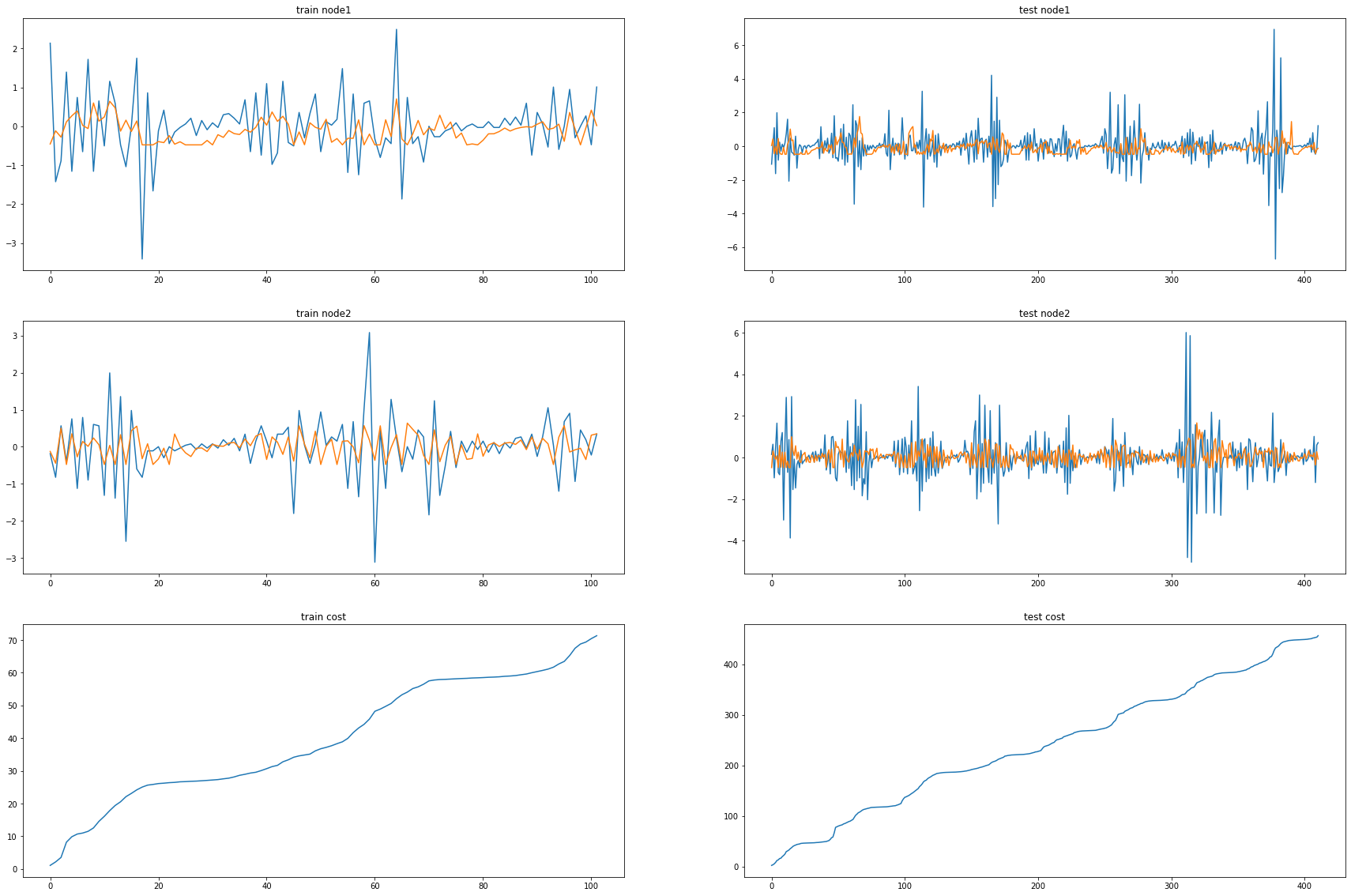
DCRNN(Done)
DCRNN?Init signature: DCRNN(in_channels: int, out_channels: int, K: int, bias: bool = True) Docstring: An implementation of the Diffusion Convolutional Gated Recurrent Unit. For details see: `"Diffusion Convolutional Recurrent Neural Network: Data-Driven Traffic Forecasting" <https://arxiv.org/abs/1707.01926>`_ Args: in_channels (int): Number of input features. out_channels (int): Number of output features. K (int): Filter size :math:`K`. bias (bool, optional): If set to :obj:`False`, the layer will not learn an additive bias (default :obj:`True`) Init docstring: Initializes internal Module state, shared by both nn.Module and ScriptModule. File: ~/anaconda3/envs/temp_csy/lib/python3.8/site-packages/torch_geometric_temporal/nn/recurrent/dcrnn.py Type: type Subclasses:
try:
from tqdm import tqdm
except ImportError:
def tqdm(iterable):
return iterable# import torch
# import torch.nn.functional as F
from torch_geometric_temporal.nn.recurrent import DCRNN
# from torch_geometric_temporal.dataset import ChickenpoxDatasetLoader
from torch_geometric_temporal.signal import temporal_signal_split
# loader = ChickenpoxDatasetLoader()
dataset = loader.get_dataset()
train_dataset, test_dataset = temporal_signal_split(dataset, train_ratio=0.2)class RecurrentGCN(torch.nn.Module):
def __init__(self, node_features):
super(RecurrentGCN, self).__init__()
self.recurrent = DCRNN(node_features, 32, 1)
self.linear = torch.nn.Linear(32, 1)
def forward(self, x, edge_index, edge_weight):
h = self.recurrent(x, edge_index, edge_weight)
h = F.relu(h)
h = self.linear(h)
return hmodel = RecurrentGCN(node_features = 4)
optimizer = torch.optim.Adam(model.parameters(), lr=0.01)
model.train()
for epoch in tqdm(range(200)):
cost = 0
_b=[]
_d=[]
for time, snapshot in enumerate(train_dataset):
y_hat = model(snapshot.x, snapshot.edge_index, snapshot.edge_attr).reshape(-1)
cost = cost + torch.mean((y_hat-snapshot.y)**2)
_b.append(y_hat)
_d.append(cost)
cost = cost / (time+1)
cost.backward()
optimizer.step()
optimizer.zero_grad()100%|██████████| 200/200 [00:21<00:00, 9.44it/s]model.eval()
cost = 0
_a = []
_a1=[]
for time, snapshot in enumerate(test_dataset):
y_hat = model(snapshot.x, snapshot.edge_index, snapshot.edge_attr).reshape(-1)
cost = cost + torch.mean((y_hat-snapshot.y)**2)
_a.append(y_hat)
_a1.append(cost)
cost = cost / (time+1)
cost = cost.item()
print("MSE: {:.4f}".format(cost))MSE: 0.1927_e = [_d[i].detach() for i in range(len(_d))]_c = [_a1[i].detach() for i in range(len(_a1))]fig, (( ax1,ax2),(ax3,ax4),(ax5,ax6)) = plt.subplots(3,2,figsize=(30,20))
ax1.set_title('train node1')
ax1.plot([train_dataset.targets[i][0] for i in range(train_dataset.snapshot_count)])
ax1.plot(torch.tensor([_b[i].detach()[0] for i in range(train_dataset.snapshot_count)]))
ax2.set_title('test node1')
ax2.plot([test_dataset.targets[i][0] for i in range(test_dataset.snapshot_count)])
ax2.plot(torch.tensor([_a[i].detach()[0] for i in range(test_dataset.snapshot_count)]))
ax3.set_title('train node2')
ax3.plot([train_dataset.targets[i][1] for i in range(train_dataset.snapshot_count)])
ax3.plot(torch.tensor([_b[i].detach()[1] for i in range(train_dataset.snapshot_count)]))
ax4.set_title('test node2')
ax4.plot([test_dataset.targets[i][1] for i in range(test_dataset.snapshot_count)])
ax4.plot(torch.tensor([_a[i].detach()[1] for i in range(test_dataset.snapshot_count)]))
ax5.set_title('train cost')
ax5.plot(_e)
ax6.set_title('test cost')
ax6.plot(_c)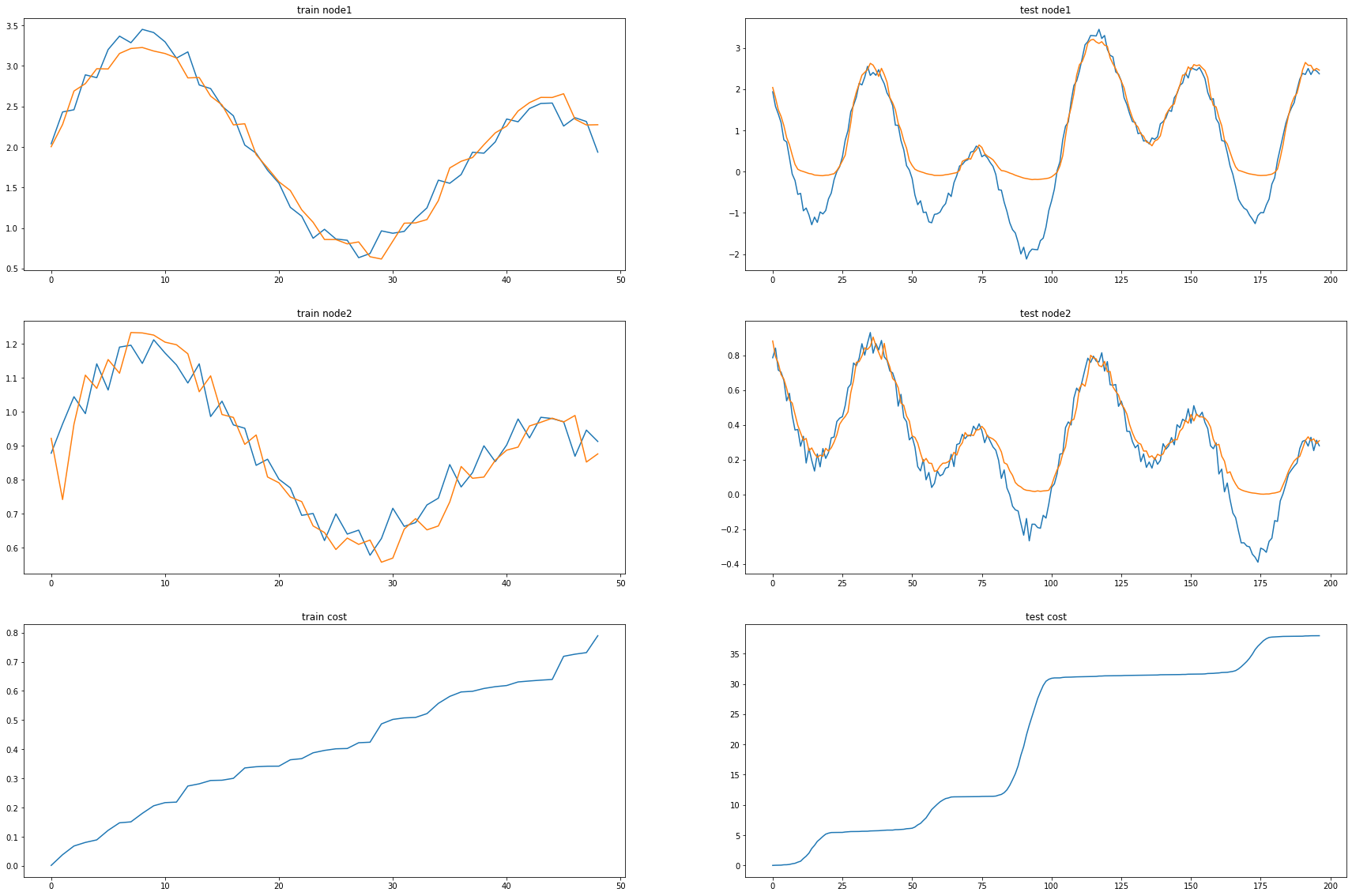
DYGRENCODER(Done)
DyGrEncoder?Init signature: DyGrEncoder( conv_out_channels: int, conv_num_layers: int, conv_aggr: str, lstm_out_channels: int, lstm_num_layers: int, ) Docstring: An implementation of the integrated Gated Graph Convolution Long Short Term Memory Layer. For details see this paper: `"Predictive Temporal Embedding of Dynamic Graphs." <https://ieeexplore.ieee.org/document/9073186>`_ Args: conv_out_channels (int): Number of output channels for the GGCN. conv_num_layers (int): Number of Gated Graph Convolutions. conv_aggr (str): Aggregation scheme to use (:obj:`"add"`, :obj:`"mean"`, :obj:`"max"`). lstm_out_channels (int): Number of LSTM channels. lstm_num_layers (int): Number of neurons in LSTM. Init docstring: Initializes internal Module state, shared by both nn.Module and ScriptModule. File: ~/anaconda3/envs/temp_csy/lib/python3.8/site-packages/torch_geometric_temporal/nn/recurrent/dygrae.py Type: type Subclasses:
try:
from tqdm import tqdm
except ImportError:
def tqdm(iterable):
return iterable# import torch
# import torch.nn.functional as F
from torch_geometric_temporal.nn.recurrent import DyGrEncoder
# from torch_geometric_temporal.dataset import ChickenpoxDatasetLoader
from torch_geometric_temporal.signal import temporal_signal_split
# loader = ChickenpoxDatasetLoader()
dataset = loader.get_dataset(lags=4)
train_dataset, test_dataset = temporal_signal_split(dataset, train_ratio=0.2)class RecurrentGCN(torch.nn.Module):
def __init__(self, node_features):
super(RecurrentGCN, self).__init__()
self.recurrent = DyGrEncoder(conv_out_channels=4, conv_num_layers=1, conv_aggr="mean", lstm_out_channels=32, lstm_num_layers=1)
self.linear = torch.nn.Linear(32, 1)
def forward(self, x, edge_index, edge_weight, h_0, c_0):
h, h_0, c_0 = self.recurrent(x, edge_index, edge_weight, h_0, c_0)
h = F.relu(h)
h = self.linear(h)
return h, h_0, c_0model = RecurrentGCN(node_features = 4)
optimizer = torch.optim.Adam(model.parameters(), lr=0.01)
model.train()
for epoch in tqdm(range(200)):
cost = 0
h, c = None, None
_b=[]
_d=[]
for time, snapshot in enumerate(train_dataset):
y_hat, h, c = model(snapshot.x, snapshot.edge_index, snapshot.edge_attr, h, c)
y_hat = y_hat.reshape(-1)
cost = cost + torch.mean((y_hat-snapshot.y)**2)
_b.append(y_hat)
_d.append(cost)
cost = cost / (time+1)
cost.backward()
optimizer.step()
optimizer.zero_grad()100%|██████████| 200/200 [00:20<00:00, 9.58it/s]model.eval()
cost = 0
h, c = None, None
_a=[]
_a1=[]
for time, snapshot in enumerate(test_dataset):
y_hat, h, c = model(snapshot.x, snapshot.edge_index, snapshot.edge_attr, h, c)
y_hat = y_hat.reshape(-1)
cost = cost + torch.mean((y_hat-snapshot.y)**2)
_a.append(y_hat)
_a1.append(cost)
cost = cost / (time+1)
cost = cost.item()
print("MSE: {:.4f}".format(cost))MSE: 0.4587_e = [_d[i].detach() for i in range(len(_d))]_c = [_a1[i].detach() for i in range(len(_a1))]fig, (( ax1,ax2),(ax3,ax4),(ax5,ax6)) = plt.subplots(3,2,figsize=(30,20))
ax1.set_title('train node1')
ax1.plot([train_dataset.targets[i][0] for i in range(train_dataset.snapshot_count)])
ax1.plot(torch.tensor([_b[i].detach()[0] for i in range(train_dataset.snapshot_count)]))
ax2.set_title('test node1')
ax2.plot([test_dataset.targets[i][0] for i in range(test_dataset.snapshot_count)])
ax2.plot(torch.tensor([_a[i].detach()[0] for i in range(test_dataset.snapshot_count)]))
ax3.set_title('train node2')
ax3.plot([train_dataset.targets[i][1] for i in range(train_dataset.snapshot_count)])
ax3.plot(torch.tensor([_b[i].detach()[1] for i in range(train_dataset.snapshot_count)]))
ax4.set_title('test node2')
ax4.plot([test_dataset.targets[i][1] for i in range(test_dataset.snapshot_count)])
ax4.plot(torch.tensor([_a[i].detach()[1] for i in range(test_dataset.snapshot_count)]))
ax5.set_title('train cost')
ax5.plot(_e)
ax6.set_title('test cost')
ax6.plot(_c)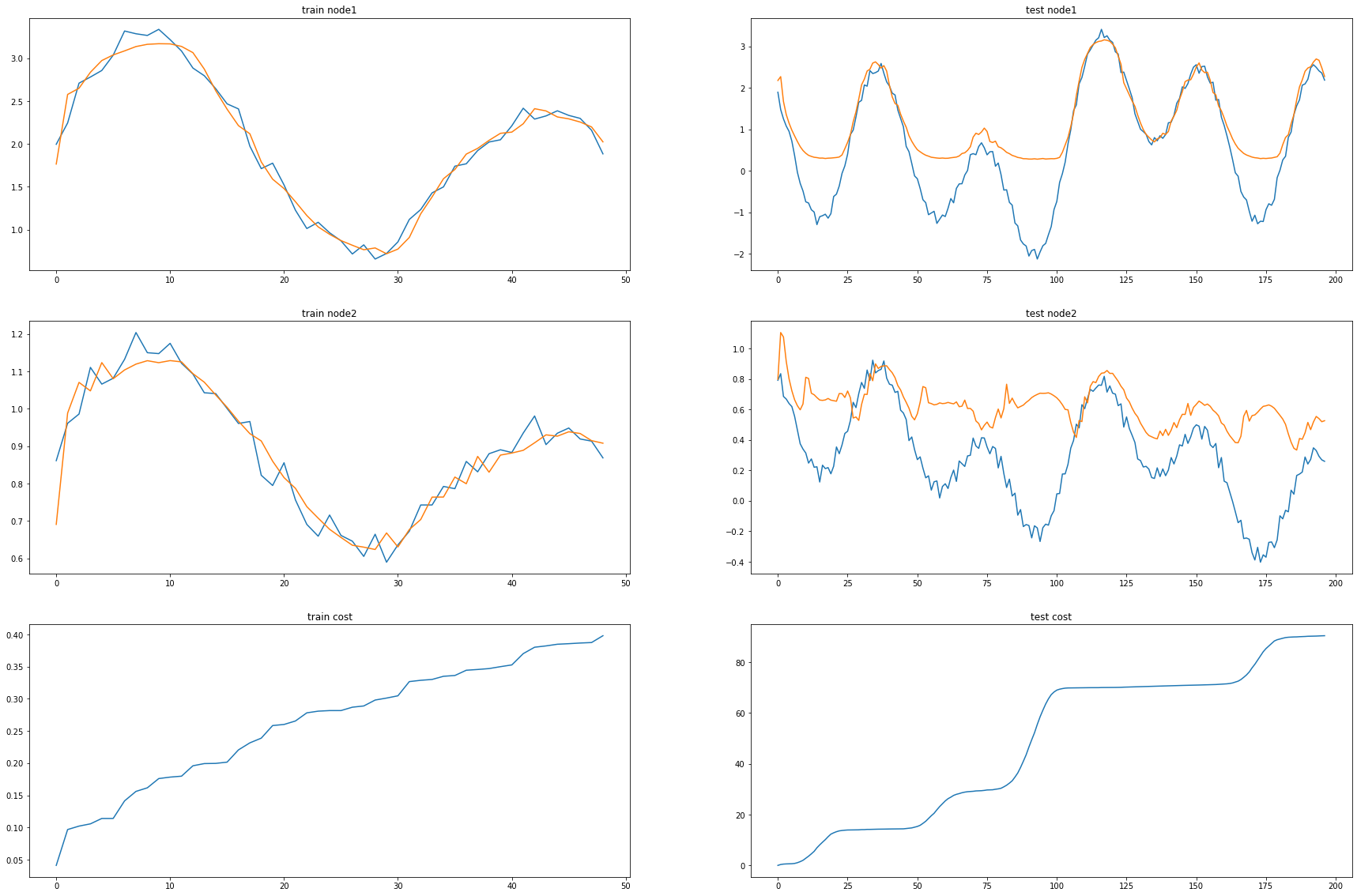
EvolveGCNH(Done)
EvolveGCNH?Init signature: EvolveGCNH( num_of_nodes: int, in_channels: int, improved: bool = False, cached: bool = False, normalize: bool = True, add_self_loops: bool = True, ) Docstring: An implementation of the Evolving Graph Convolutional Hidden Layer. For details see this paper: `"EvolveGCN: Evolving Graph Convolutional Networks for Dynamic Graph." <https://arxiv.org/abs/1902.10191>`_ Args: num_of_nodes (int): Number of vertices. in_channels (int): Number of filters. improved (bool, optional): If set to :obj:`True`, the layer computes :math:`\mathbf{\hat{A}}` as :math:`\mathbf{A} + 2\mathbf{I}`. (default: :obj:`False`) cached (bool, optional): If set to :obj:`True`, the layer will cache the computation of :math:`\mathbf{\hat{D}}^{-1/2} \mathbf{\hat{A}} \mathbf{\hat{D}}^{-1/2}` on first execution, and will use the cached version for further executions. This parameter should only be set to :obj:`True` in transductive learning scenarios. (default: :obj:`False`) normalize (bool, optional): Whether to add self-loops and apply symmetric normalization. (default: :obj:`True`) add_self_loops (bool, optional): If set to :obj:`False`, will not add self-loops to the input graph. (default: :obj:`True`) Init docstring: Initializes internal Module state, shared by both nn.Module and ScriptModule. File: ~/anaconda3/envs/temp_csy/lib/python3.8/site-packages/torch_geometric_temporal/nn/recurrent/evolvegcnh.py Type: type Subclasses:
try:
from tqdm import tqdm
except ImportError:
def tqdm(iterable):
return iterable# import torch
# import torch.nn.functional as F
from torch_geometric_temporal.nn.recurrent import EvolveGCNH
from torch_geometric_temporal.dataset import ChickenpoxDatasetLoader
from torch_geometric_temporal.signal import temporal_signal_split
loader1 = ChickenpoxDatasetLoader()
dataset = loader1.get_dataset(lags=4)
train_dataset, test_dataset = temporal_signal_split(dataset, train_ratio=0.2)class RecurrentGCN(torch.nn.Module):
def __init__(self, num_of_nodes, in_channels):
super(RecurrentGCN, self).__init__()
self.recurrent = EvolveGCNH(num_of_nodes, in_channels)
self.linear = torch.nn.Linear(in_channels, 1)
def forward(self, x, edge_index, edge_weight):
h = self.recurrent(x, edge_index, edge_weight)
h = F.relu(h)
h = self.linear(h)
return hmodel = RecurrentGCN(num_of_nodes = 20,in_channels = 4)
optimizer = torch.optim.Adam(model.parameters(), lr=0.01)
model.train()
for epoch in tqdm(range(200)):
cost = 0
_b=[]
_d=[]
for time, snapshot in enumerate(train_dataset):
y_hat = model(snapshot.x, snapshot.edge_index, snapshot.edge_attr).reshape(-1)
cost = cost + torch.mean((y_hat-snapshot.y)**2)
_b.append(y_hat)
_d.append(cost)
cost = cost / (time+1)
cost.backward()
optimizer.step()
optimizer.zero_grad()100%|██████████| 200/200 [00:33<00:00, 5.96it/s]model.eval()
cost = 0
_a=[]
_a1=[]
for time, snapshot in enumerate(test_dataset):
y_hat = model(snapshot.x, snapshot.edge_index, snapshot.edge_attr).reshape(-1)
cost = cost + torch.mean((y_hat-snapshot.y)**2)
_a.append(y_hat)
_a1.append(cost)
cost = cost / (time+1)
cost = cost.item()
print("MSE: {:.4f}".format(cost))MSE: 0.9995_e = [_d[i].detach() for i in range(len(_d))]_c = [_a1[i].detach() for i in range(len(_a1))]fig, (( ax1,ax2),(ax3,ax4),(ax5,ax6)) = plt.subplots(3,2,figsize=(30,20))
ax1.set_title('train node1')
ax1.plot([train_dataset.targets[i][0] for i in range(train_dataset.snapshot_count)])
ax1.plot(torch.tensor([_b[i].detach()[0] for i in range(train_dataset.snapshot_count)]))
ax2.set_title('test node1')
ax2.plot([test_dataset.targets[i][0] for i in range(test_dataset.snapshot_count)])
ax2.plot(torch.tensor([_a[i].detach()[0] for i in range(test_dataset.snapshot_count)]))
ax3.set_title('train node2')
ax3.plot([train_dataset.targets[i][1] for i in range(train_dataset.snapshot_count)])
ax3.plot(torch.tensor([_b[i].detach()[1] for i in range(train_dataset.snapshot_count)]))
ax4.set_title('test node2')
ax4.plot([test_dataset.targets[i][1] for i in range(test_dataset.snapshot_count)])
ax4.plot(torch.tensor([_a[i].detach()[1] for i in range(test_dataset.snapshot_count)]))
ax5.set_title('train cost')
ax5.plot(_e)
ax6.set_title('test cost')
ax6.plot(_c)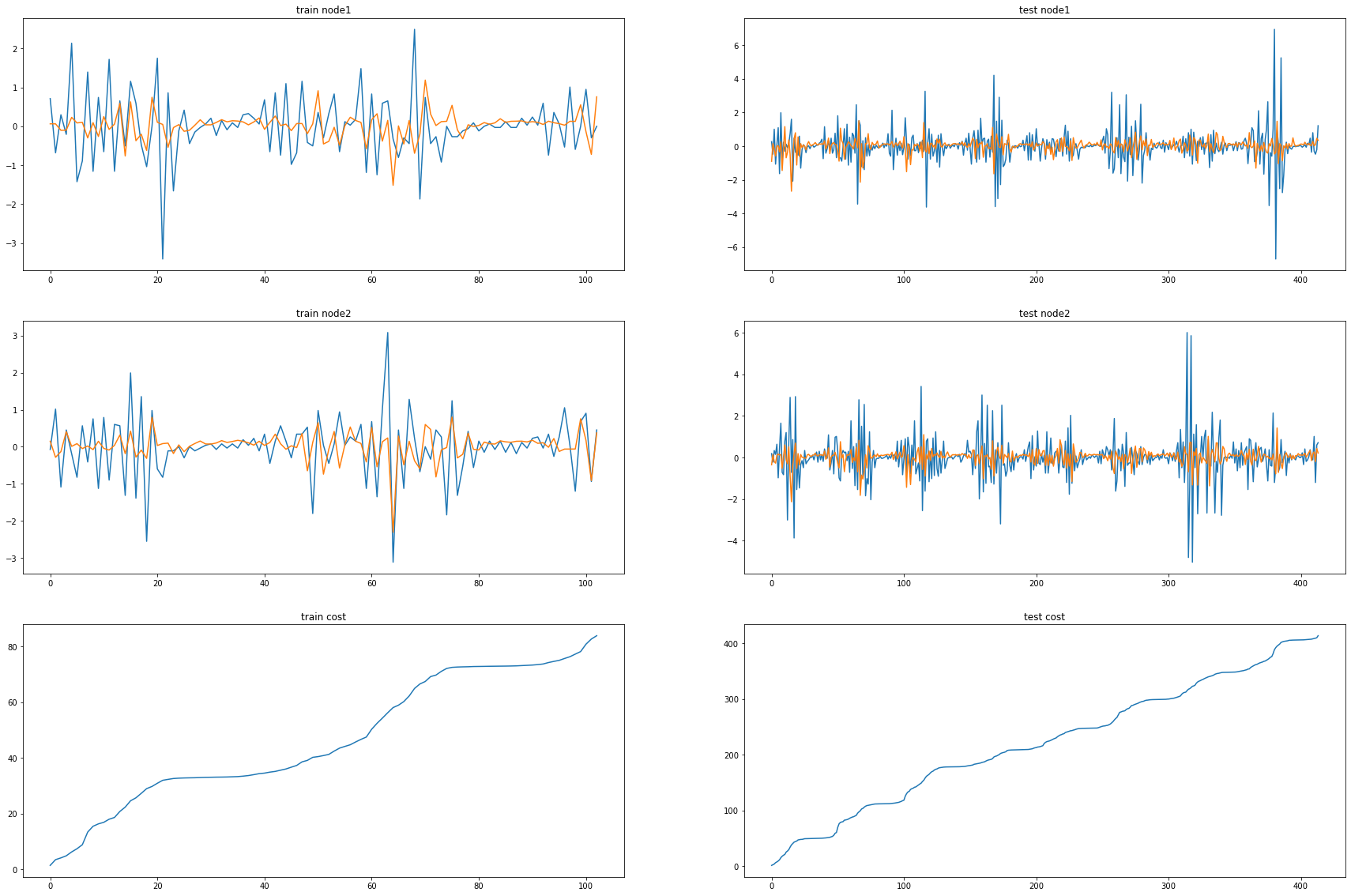
EVOLVEGCNO(Done)
EvolveGCNO?Init signature: EvolveGCNO( in_channels: int, improved: bool = False, cached: bool = False, normalize: bool = True, add_self_loops: bool = True, ) Docstring: An implementation of the Evolving Graph Convolutional without Hidden Layer. For details see this paper: `"EvolveGCN: Evolving Graph Convolutional Networks for Dynamic Graph." <https://arxiv.org/abs/1902.10191>`_ Args: in_channels (int): Number of filters. improved (bool, optional): If set to :obj:`True`, the layer computes :math:`\mathbf{\hat{A}}` as :math:`\mathbf{A} + 2\mathbf{I}`. (default: :obj:`False`) cached (bool, optional): If set to :obj:`True`, the layer will cache the computation of :math:`\mathbf{\hat{D}}^{-1/2} \mathbf{\hat{A}} \mathbf{\hat{D}}^{-1/2}` on first execution, and will use the cached version for further executions. This parameter should only be set to :obj:`True` in transductive learning scenarios. (default: :obj:`False`) normalize (bool, optional): Whether to add self-loops and apply symmetric normalization. (default: :obj:`True`) add_self_loops (bool, optional): If set to :obj:`False`, will not add self-loops to the input graph. (default: :obj:`True`) Init docstring: Initializes internal Module state, shared by both nn.Module and ScriptModule. File: ~/anaconda3/envs/temp_csy/lib/python3.8/site-packages/torch_geometric_temporal/nn/recurrent/evolvegcno.py Type: type Subclasses:
try:
from tqdm import tqdm
except ImportError:
def tqdm(iterable):
return iterable# import torch
# import torch.nn.functional as F
from torch_geometric_temporal.nn.recurrent import EvolveGCNO
# from torch_geometric_temporal.dataset import ChickenpoxDatasetLoader
from torch_geometric_temporal.signal import temporal_signal_split
# loader = ChickenpoxDatasetLoader()
dataset = loader.get_dataset(lags=4)
train_dataset, test_dataset = temporal_signal_split(dataset, train_ratio=0.2)class RecurrentGCN(torch.nn.Module):
def __init__(self, node_features):
super(RecurrentGCN, self).__init__()
self.recurrent = EvolveGCNO(node_features)
self.linear = torch.nn.Linear(node_features, 1)
def forward(self, x, edge_index, edge_weight):
h = self.recurrent(x, edge_index, edge_weight)
h = F.relu(h)
h = self.linear(h)
return hmodel = RecurrentGCN(node_features = 4)
for param in model.parameters():
param.retain_grad()
optimizer = torch.optim.Adam(model.parameters(), lr=0.01)
model.train()
for epoch in tqdm(range(200)):
cost = 0
_b=[]
_d=[]
for time, snapshot in enumerate(train_dataset):
y_hat = model(snapshot.x, snapshot.edge_index, snapshot.edge_attr).reshape(-1)
cost = cost + torch.mean((y_hat-snapshot.y)**2)
_b.append(y_hat)
_d.append(cost)
cost = cost / (time+1)
cost.backward(retain_graph=True)
optimizer.step()
optimizer.zero_grad()100%|██████████| 200/200 [00:08<00:00, 22.31it/s]model.eval()
cost = 0
_a=[]
_a1=[]
for time, snapshot in enumerate(test_dataset):
if time == 0:
model.recurrent.weight = None
y_hat = model(snapshot.x, snapshot.edge_index, snapshot.edge_attr).reshape(-1)
cost = cost + torch.mean((y_hat-snapshot.y)**2)
_a.append(y_hat)
_a1.append(cost)
cost = cost / (time+1)
cost = cost.item()
print("MSE: {:.4f}".format(cost))MSE: 0.5661_e = [_d[i].detach() for i in range(len(_d))]_c = [_a1[i].detach() for i in range(len(_a1))]fig, (( ax1,ax2),(ax3,ax4),(ax5,ax6)) = plt.subplots(3,2,figsize=(30,20))
ax1.set_title('train node1')
ax1.plot([train_dataset.targets[i][0] for i in range(train_dataset.snapshot_count)])
ax1.plot(torch.tensor([_b[i].detach()[0] for i in range(train_dataset.snapshot_count)]))
ax2.set_title('test node1')
ax2.plot([test_dataset.targets[i][0] for i in range(test_dataset.snapshot_count)])
ax2.plot(torch.tensor([_a[i].detach()[0] for i in range(test_dataset.snapshot_count)]))
ax3.set_title('train node2')
ax3.plot([train_dataset.targets[i][1] for i in range(train_dataset.snapshot_count)])
ax3.plot(torch.tensor([_b[i].detach()[1] for i in range(train_dataset.snapshot_count)]))
ax4.set_title('test node2')
ax4.plot([test_dataset.targets[i][1] for i in range(test_dataset.snapshot_count)])
ax4.plot(torch.tensor([_a[i].detach()[1] for i in range(test_dataset.snapshot_count)]))
ax5.set_title('train cost')
ax5.plot(_e)
ax6.set_title('test cost')
ax6.plot(_c)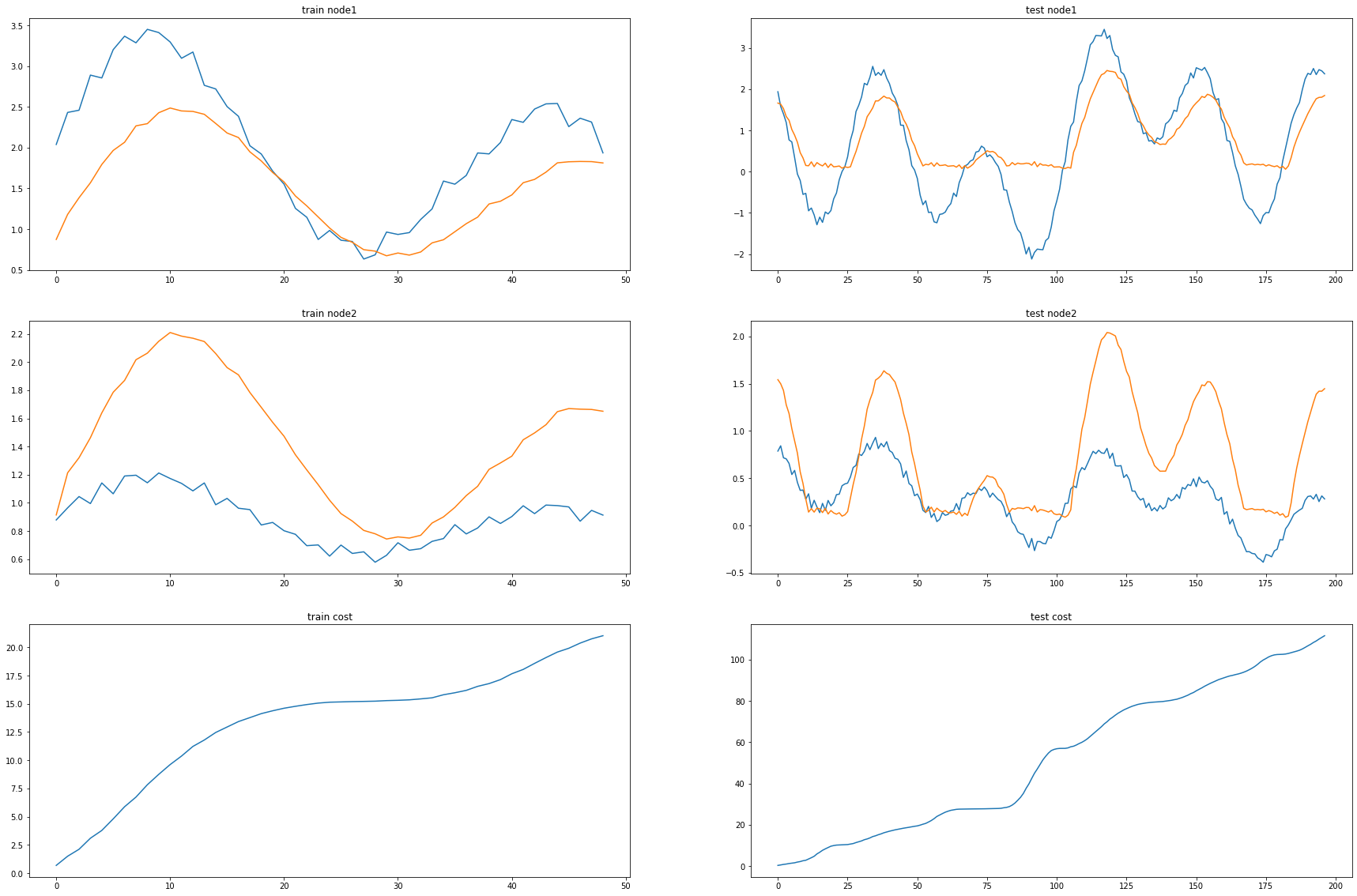
GCLSTM(Done)
GCLSTM?Init signature: GCLSTM( in_channels: int, out_channels: int, K: int, normalization: str = 'sym', bias: bool = True, ) Docstring: An implementation of the the Integrated Graph Convolutional Long Short Term Memory Cell. For details see this paper: `"GC-LSTM: Graph Convolution Embedded LSTM for Dynamic Link Prediction." <https://arxiv.org/abs/1812.04206>`_ Args: in_channels (int): Number of input features. out_channels (int): Number of output features. K (int): Chebyshev filter size :math:`K`. normalization (str, optional): The normalization scheme for the graph Laplacian (default: :obj:`"sym"`): 1. :obj:`None`: No normalization :math:`\mathbf{L} = \mathbf{D} - \mathbf{A}` 2. :obj:`"sym"`: Symmetric normalization :math:`\mathbf{L} = \mathbf{I} - \mathbf{D}^{-1/2} \mathbf{A} \mathbf{D}^{-1/2}` 3. :obj:`"rw"`: Random-walk normalization :math:`\mathbf{L} = \mathbf{I} - \mathbf{D}^{-1} \mathbf{A}` You need to pass :obj:`lambda_max` to the :meth:`forward` method of this operator in case the normalization is non-symmetric. :obj:`\lambda_max` should be a :class:`torch.Tensor` of size :obj:`[num_graphs]` in a mini-batch scenario and a scalar/zero-dimensional tensor when operating on single graphs. You can pre-compute :obj:`lambda_max` via the :class:`torch_geometric.transforms.LaplacianLambdaMax` transform. bias (bool, optional): If set to :obj:`False`, the layer will not learn an additive bias. (default: :obj:`True`) Init docstring: Initializes internal Module state, shared by both nn.Module and ScriptModule. File: ~/anaconda3/envs/temp_csy/lib/python3.8/site-packages/torch_geometric_temporal/nn/recurrent/gc_lstm.py Type: type Subclasses:
try:
from tqdm import tqdm
except ImportError:
def tqdm(iterable):
return iterableimport torch
import torch.nn.functional as F
from torch_geometric_temporal.nn.recurrent import GCLSTM
# from torch_geometric_temporal.dataset import ChickenpoxDatasetLoader
from torch_geometric_temporal.signal import temporal_signal_split
# loader = ChickenpoxDatasetLoader()
dataset = loader.get_dataset()
train_dataset, test_dataset = temporal_signal_split(dataset, train_ratio=0.2)class RecurrentGCN(torch.nn.Module):
def __init__(self, node_features):
super(RecurrentGCN, self).__init__()
self.recurrent = GCLSTM(node_features, 32, 1)
self.linear = torch.nn.Linear(32, 1)
def forward(self, x, edge_index, edge_weight, h, c):
h_0, c_0 = self.recurrent(x, edge_index, edge_weight, h, c)
h = F.relu(h_0)
h = self.linear(h)
return h, h_0, c_0model = RecurrentGCN(node_features=4)
optimizer = torch.optim.Adam(model.parameters(), lr=0.01)
model.train()
for epoch in tqdm(range(100)): #200
cost = 0
h, c = None, None
_b=[]
_d=[]
for time, snapshot in enumerate(train_dataset):
y_hat, h, c = model(snapshot.x, snapshot.edge_index, snapshot.edge_attr, h, c)
y_hat = y_hat.reshape(-1)
cost = cost + torch.mean((y_hat-snapshot.y)**2)
_b.append(y_hat)
_d.append(cost)
cost = cost / (time+1)
cost.backward()
optimizer.step()
optimizer.zero_grad()100%|██████████| 100/100 [00:10<00:00, 9.17it/s]model.eval()
cost = 0
_a=[]
_a1=[]
for time, snapshot in enumerate(test_dataset):
y_hat, h, c = model(snapshot.x, snapshot.edge_index, snapshot.edge_attr, h, c)
y_hat = y_hat.reshape(-1)
cost = cost + torch.mean((y_hat-snapshot.y)**2)
_a.append(y_hat)
_a1.append(cost)
cost = cost / (time+1)
cost = cost.item()
print("MSE: {:.4f}".format(cost))MSE: 0.2557_e = [_d[i].detach() for i in range(len(_d))]_c = [_a1[i].detach() for i in range(len(_a1))]fig, (( ax1,ax2),(ax3,ax4),(ax5,ax6)) = plt.subplots(3,2,figsize=(30,20))
ax1.set_title('train node1')
ax1.plot([train_dataset.targets[i][0] for i in range(train_dataset.snapshot_count)])
ax1.plot(torch.tensor([_b[i].detach()[0] for i in range(train_dataset.snapshot_count)]))
ax2.set_title('test node1')
ax2.plot([test_dataset.targets[i][0] for i in range(test_dataset.snapshot_count)])
ax2.plot(torch.tensor([_a[i].detach()[0] for i in range(test_dataset.snapshot_count)]))
ax3.set_title('train node2')
ax3.plot([train_dataset.targets[i][1] for i in range(train_dataset.snapshot_count)])
ax3.plot(torch.tensor([_b[i].detach()[1] for i in range(train_dataset.snapshot_count)]))
ax4.set_title('test node2')
ax4.plot([test_dataset.targets[i][1] for i in range(test_dataset.snapshot_count)])
ax4.plot(torch.tensor([_a[i].detach()[1] for i in range(test_dataset.snapshot_count)]))
ax5.set_title('train cost')
ax5.plot(_e)
ax6.set_title('test cost')
ax6.plot(_c)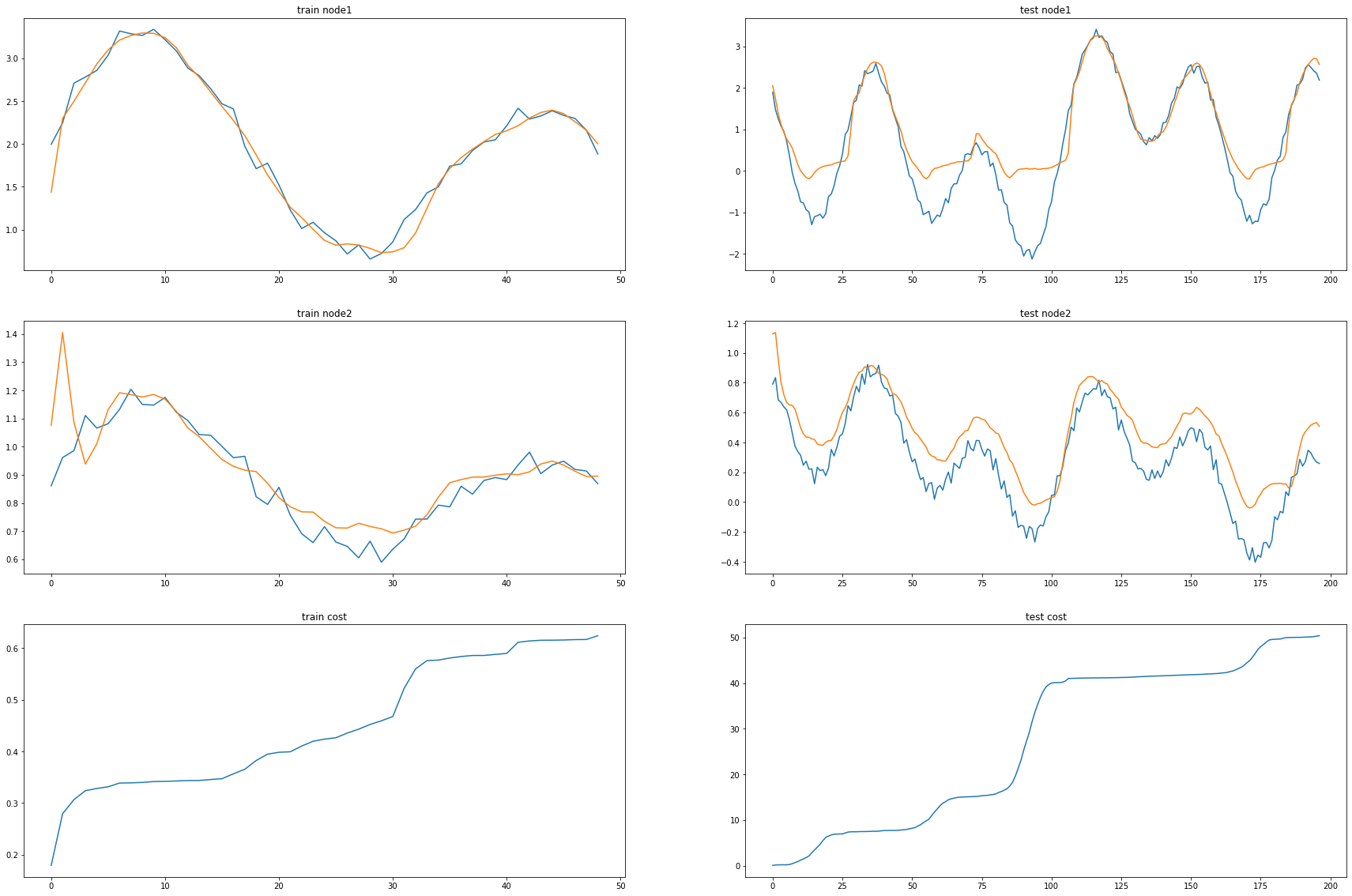
GConvLSTM(Done)
GConvLSTM?Init signature: GConvLSTM( in_channels: int, out_channels: int, K: int, normalization: str = 'sym', bias: bool = True, ) Docstring: An implementation of the Chebyshev Graph Convolutional Long Short Term Memory Cell. For details see this paper: `"Structured Sequence Modeling with Graph Convolutional Recurrent Networks." <https://arxiv.org/abs/1612.07659>`_ Args: in_channels (int): Number of input features. out_channels (int): Number of output features. K (int): Chebyshev filter size :math:`K`. normalization (str, optional): The normalization scheme for the graph Laplacian (default: :obj:`"sym"`): 1. :obj:`None`: No normalization :math:`\mathbf{L} = \mathbf{D} - \mathbf{A}` 2. :obj:`"sym"`: Symmetric normalization :math:`\mathbf{L} = \mathbf{I} - \mathbf{D}^{-1/2} \mathbf{A} \mathbf{D}^{-1/2}` 3. :obj:`"rw"`: Random-walk normalization :math:`\mathbf{L} = \mathbf{I} - \mathbf{D}^{-1} \mathbf{A}` You need to pass :obj:`lambda_max` to the :meth:`forward` method of this operator in case the normalization is non-symmetric. :obj:`\lambda_max` should be a :class:`torch.Tensor` of size :obj:`[num_graphs]` in a mini-batch scenario and a scalar/zero-dimensional tensor when operating on single graphs. You can pre-compute :obj:`lambda_max` via the :class:`torch_geometric.transforms.LaplacianLambdaMax` transform. bias (bool, optional): If set to :obj:`False`, the layer will not learn an additive bias. (default: :obj:`True`) Init docstring: Initializes internal Module state, shared by both nn.Module and ScriptModule. File: ~/anaconda3/envs/temp_csy/lib/python3.8/site-packages/torch_geometric_temporal/nn/recurrent/gconv_lstm.py Type: type Subclasses:
try:
from tqdm import tqdm
except ImportError:
def tqdm(iterable):
return iterable# import torch
# import torch.nn.functional as F
from torch_geometric_temporal.nn.recurrent import GConvLSTM
from torch_geometric_temporal.dataset import ChickenpoxDatasetLoader
from torch_geometric_temporal.signal import temporal_signal_split
loader1 = ChickenpoxDatasetLoader()
dataset = loader1.get_dataset(lags=4)
train_dataset, test_dataset = temporal_signal_split(dataset, train_ratio=0.2)class RecurrentGCN(torch.nn.Module):
def __init__(self, node_features):
super(RecurrentGCN, self).__init__()
self.recurrent = GConvLSTM(node_features, 8, 1)
self.linear = torch.nn.Linear(8, 1)
def forward(self, x, edge_index, edge_weight, h, c):
h_0, c_0 = self.recurrent(x, edge_index, edge_weight, h, c)
h = F.relu(h_0)
h = self.linear(h)
return h, h_0, c_0model = RecurrentGCN(node_features=4)
optimizer = torch.optim.Adam(model.parameters(), lr=0.01)
model.train()
for epoch in tqdm(range(50)): #200
cost = 0
h, c = None, None
_b = []
_d=[]
for time, snapshot in enumerate(train_dataset):
y_hat, h, c = model(snapshot.x, snapshot.edge_index, snapshot.edge_attr, h, c)
y_hat = y_hat.reshape(-1)
cost = cost + torch.mean((y_hat-snapshot.y)**2)
_b.append(y_hat)
_d.append(cost)
cost = cost / (time+1)
cost.backward()
optimizer.step()
optimizer.zero_grad()100%|██████████| 50/50 [00:30<00:00, 1.66it/s]model.eval()
cost = 0
_a=[]
_a1=[]
for time, snapshot in enumerate(test_dataset):
y_hat, h, c = model(snapshot.x, snapshot.edge_index, snapshot.edge_attr, h, c)
y_hat = y_hat.reshape(-1)
cost = cost + torch.mean((y_hat-snapshot.y)**2)
_a.append(y_hat)
_a1.append(cost)
cost = cost / (time+1)
cost = cost.item()
print("MSE: {:.4f}".format(cost))MSE: 0.7228_e = [_d[i].detach() for i in range(len(_d))]_c = [_a1[i].detach() for i in range(len(_a1))]fig, (( ax1,ax2),(ax3,ax4),(ax5,ax6)) = plt.subplots(3,2,figsize=(30,20))
ax1.set_title('train node1')
ax1.plot([train_dataset.targets[i][0] for i in range(train_dataset.snapshot_count)])
ax1.plot(torch.tensor([_b[i].detach()[0] for i in range(train_dataset.snapshot_count)]))
ax2.set_title('test node1')
ax2.plot([test_dataset.targets[i][0] for i in range(test_dataset.snapshot_count)])
ax2.plot(torch.tensor([_a[i].detach()[0] for i in range(test_dataset.snapshot_count)]))
ax3.set_title('train node2')
ax3.plot([train_dataset.targets[i][1] for i in range(train_dataset.snapshot_count)])
ax3.plot(torch.tensor([_b[i].detach()[1] for i in range(train_dataset.snapshot_count)]))
ax4.set_title('test node2')
ax4.plot([test_dataset.targets[i][1] for i in range(test_dataset.snapshot_count)])
ax4.plot(torch.tensor([_a[i].detach()[1] for i in range(test_dataset.snapshot_count)]))
ax5.set_title('train cost')
ax5.plot(_e)
ax6.set_title('test cost')
ax6.plot(_c)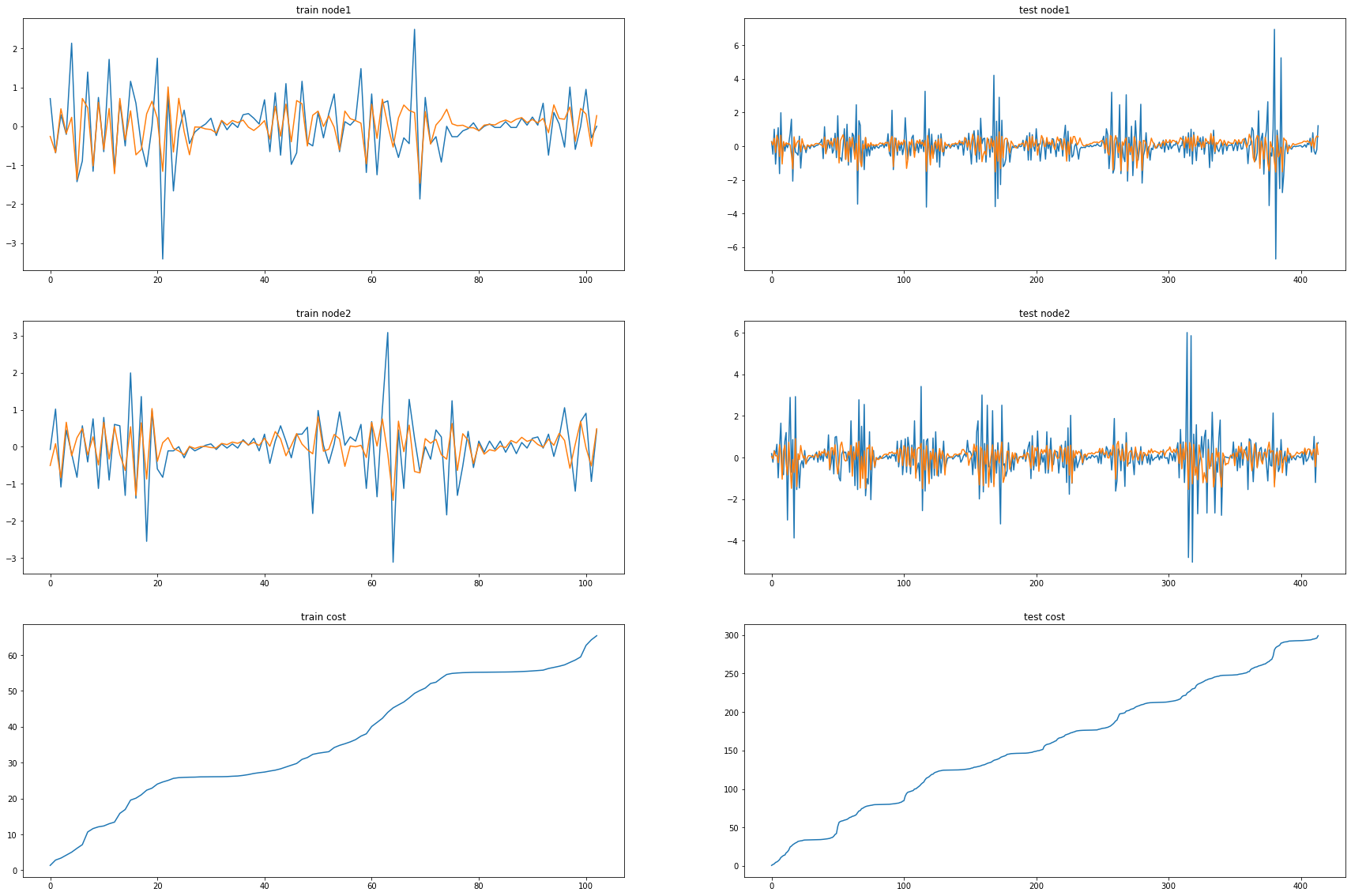
Lightning(설치 안 됨)
# import torch
# from torch.nn import functional as F
# import pytorch_lightning as pl
# from pytorch_lightning.callbacks.early_stopping import EarlyStopping
# from torch_geometric_temporal.nn.recurrent import DCRNN
# from torch_geometric_temporal.dataset import ChickenpoxDatasetLoader
# from torch_geometric_temporal.signal import temporal_signal_split# class LitDiffConvModel(pl.LightningModule):
# def __init__(self, node_features, filters):
# super().__init__()
# self.recurrent = DCRNN(node_features, filters, 1)
# self.linear = torch.nn.Linear(filters, 1)
# def configure_optimizers(self):
# optimizer = torch.optim.Adam(self.parameters(), lr=1e-2)
# return optimizer
# def training_step(self, train_batch, batch_idx):
# x = train_batch.x
# y = train_batch.y.view(-1, 1)
# edge_index = train_batch.edge_index
# h = self.recurrent(x, edge_index)
# h = F.relu(h)
# h = self.linear(h)
# loss = F.mse_loss(h, y)
# return loss
# def validation_step(self, val_batch, batch_idx):
# x = val_batch.x
# y = val_batch.y.view(-1, 1)
# edge_index = val_batch.edge_index
# h = self.recurrent(x, edge_index)
# h = F.relu(h)
# h = self.linear(h)
# loss = F.mse_loss(h, y)
# metrics = {'val_loss': loss}
# self.log_dict(metrics)
# return metrics# loader = ChickenpoxDatasetLoader()
# dataset_loader = loader.get_dataset(lags=32)
# train_loader, val_loader = temporal_signal_split(dataset_loader,
# train_ratio=0.2)# model = LitDiffConvModel(node_features=32,
# filters=16)# early_stop_callback = EarlyStopping(monitor='val_loss',
# min_delta=0.00,
# patience=10,
# verbose=False,
# mode='max')# trainer = pl.Trainer(callbacks=[early_stop_callback])# trainer.fit(model, train_loader, val_loader)LRGCN(Done)
LRGCN?Init signature: LRGCN( in_channels: int, out_channels: int, num_relations: int, num_bases: int, ) Docstring: An implementation of the Long Short Term Memory Relational Graph Convolution Layer. For details see this paper: `"Predicting Path Failure In Time-Evolving Graphs." <https://arxiv.org/abs/1905.03994>`_ Args: in_channels (int): Number of input features. out_channels (int): Number of output features. num_relations (int): Number of relations. num_bases (int): Number of bases. Init docstring: Initializes internal Module state, shared by both nn.Module and ScriptModule. File: ~/anaconda3/envs/temp_csy/lib/python3.8/site-packages/torch_geometric_temporal/nn/recurrent/lrgcn.py Type: type Subclasses:
try:
from tqdm import tqdm
except ImportError:
def tqdm(iterable):
return iterable# import torch
# import torch.nn.functional as F
from torch_geometric_temporal.nn.recurrent import LRGCN
# from torch_geometric_temporal.dataset import ChickenpoxDatasetLoader
from torch_geometric_temporal.signal import temporal_signal_split
# loader = ChickenpoxDatasetLoader()
dataset = loader.get_dataset()
train_dataset, test_dataset = temporal_signal_split(dataset, train_ratio=0.2)class RecurrentGCN(torch.nn.Module):
def __init__(self, node_features):
super(RecurrentGCN, self).__init__()
self.recurrent = LRGCN(node_features, 32, 1, 1)
self.linear = torch.nn.Linear(32, 1)
def forward(self, x, edge_index, edge_weight, h_0, c_0):
h_0, c_0 = self.recurrent(x, edge_index, edge_weight, h_0, c_0)
h = F.relu(h_0)
h = self.linear(h)
return h, h_0, c_0model = RecurrentGCN(node_features = 4)
optimizer = torch.optim.Adam(model.parameters(), lr=0.01)
model.train()
for epoch in tqdm(range(200)):
cost = 0
h, c = None, None
_b=[]
_d=[]
for time, snapshot in enumerate(train_dataset):
y_hat, h, c = model(snapshot.x, snapshot.edge_index, snapshot.edge_attr, h, c)
y_hat = y_hat.reshape(-1)
cost = cost + torch.mean((y_hat-snapshot.y)**2)
_b.append(y_hat)
_d.append(cost)
cost = cost / (time+1)
cost.backward()
optimizer.step()
optimizer.zero_grad()100%|██████████| 200/200 [00:47<00:00, 4.23it/s]model.eval()
cost = 0
h, c = None, None
_a=[]
_a1=[]
for time, snapshot in enumerate(test_dataset):
y_hat, h, c = model(snapshot.x, snapshot.edge_index, snapshot.edge_attr, h, c)
y_hat = y_hat.reshape(-1)
cost = cost + torch.mean((y_hat-snapshot.y)**2)
_a.append(y_hat)
_a1.append(cost)
cost = cost / (time+1)
cost = cost.item()
print("MSE: {:.4f}".format(cost))MSE: 0.2608_e = [_d[i].detach() for i in range(len(_d))]_c = [_a1[i].detach() for i in range(len(_a1))]fig, (( ax1,ax2),(ax3,ax4),(ax5,ax6)) = plt.subplots(3,2,figsize=(30,20))
ax1.set_title('train node1')
ax1.plot([train_dataset.targets[i][0] for i in range(train_dataset.snapshot_count)])
ax1.plot(torch.tensor([_b[i].detach()[0] for i in range(train_dataset.snapshot_count)]))
ax2.set_title('test node1')
ax2.plot([test_dataset.targets[i][0] for i in range(test_dataset.snapshot_count)])
ax2.plot(torch.tensor([_a[i].detach()[0] for i in range(test_dataset.snapshot_count)]))
ax3.set_title('train node2')
ax3.plot([train_dataset.targets[i][1] for i in range(train_dataset.snapshot_count)])
ax3.plot(torch.tensor([_b[i].detach()[1] for i in range(train_dataset.snapshot_count)]))
ax4.set_title('test node2')
ax4.plot([test_dataset.targets[i][1] for i in range(test_dataset.snapshot_count)])
ax4.plot(torch.tensor([_a[i].detach()[1] for i in range(test_dataset.snapshot_count)]))
ax5.set_title('train cost')
ax5.plot(_e)
ax6.set_title('test cost')
ax6.plot(_c)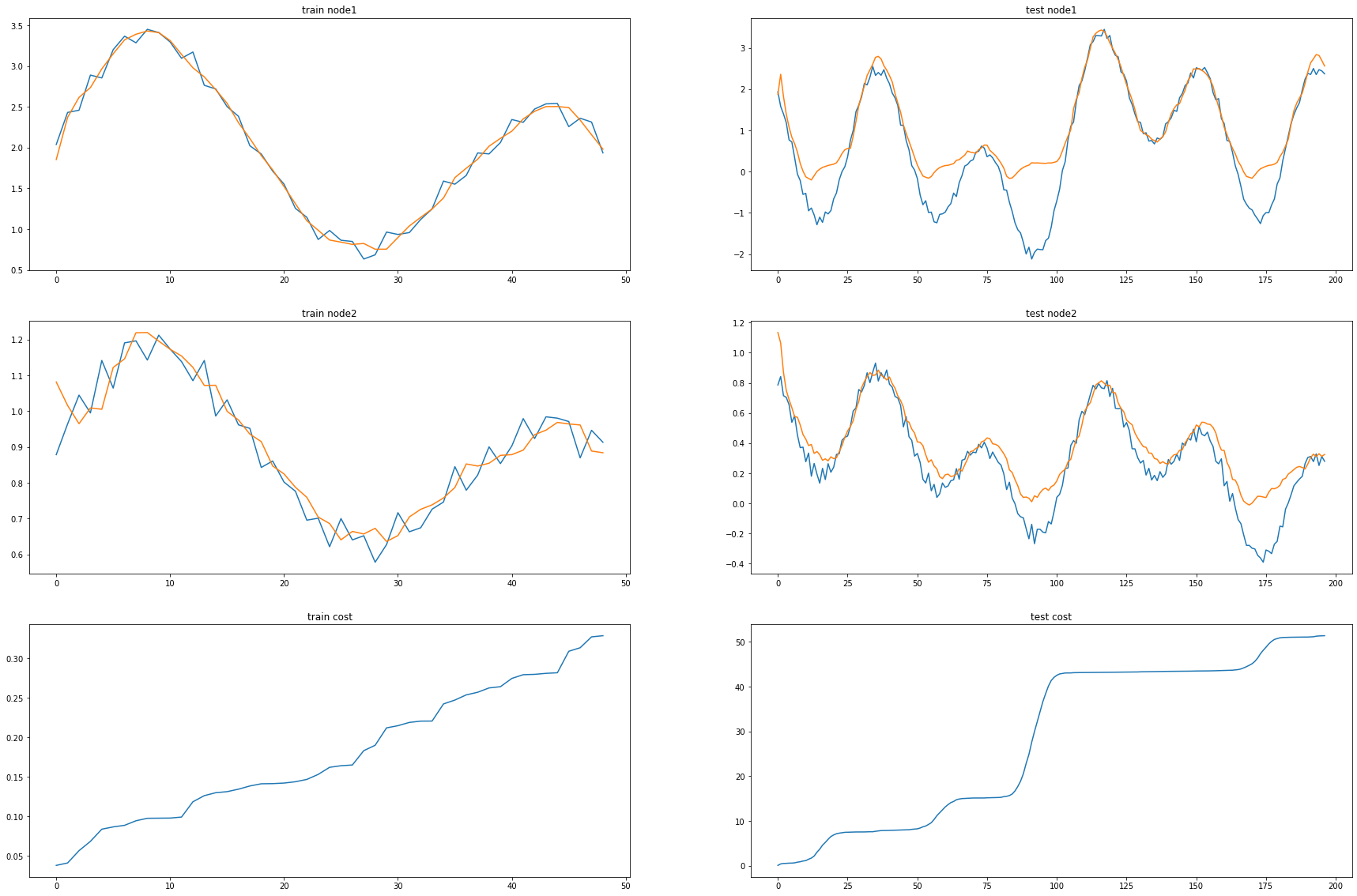
MPNNLSTM
MPNNLSTM?Init signature: MPNNLSTM( in_channels: int, hidden_size: int, num_nodes: int, window: int, dropout: float, ) Docstring: An implementation of the Message Passing Neural Network with Long Short Term Memory. For details see this paper: `"Transfer Graph Neural Networks for Pandemic Forecasting." <https://arxiv.org/abs/2009.08388>`_ Args: in_channels (int): Number of input features. hidden_size (int): Dimension of hidden representations. num_nodes (int): Number of nodes in the network. window (int): Number of past samples included in the input. dropout (float): Dropout rate. Init docstring: Initializes internal Module state, shared by both nn.Module and ScriptModule. File: ~/anaconda3/envs/temp_csy/lib/python3.8/site-packages/torch_geometric_temporal/nn/recurrent/mpnn_lstm.py Type: type Subclasses:
try:
from tqdm import tqdm
except ImportError:
def tqdm(iterable):
return iterable# import torch
# import torch.nn.functional as F
from torch_geometric_temporal.nn.recurrent import MPNNLSTM
# from torch_geometric_temporal.dataset import ChickenpoxDatasetLoader
from torch_geometric_temporal.signal import temporal_signal_split
# loader = ChickenpoxDatasetLoader()
dataset = loader.get_dataset()
train_dataset, test_dataset = temporal_signal_split(dataset, train_ratio=0.2)num_nodes=2class RecurrentGCN(torch.nn.Module):
def __init__(self, node_features):
super(RecurrentGCN, self).__init__()
self.recurrent = MPNNLSTM(node_features, 8, num_nodes, 1, 0.3) # 32, 32, 20, 1, 0.5 이었는데 position 잘못되었다해서 32하나 뺌
self.linear = torch.nn.Linear(num_nodes*8 + node_features, 1)
def forward(self, x, edge_index, edge_weight):
h = self.recurrent(x, edge_index, edge_weight)
h = F.relu(h)
h = self.linear(h)
return hmodel = RecurrentGCN(node_features = 4)optimizer = torch.optim.Adam(model.parameters(), lr=0.01)
model.train()
for epoch in tqdm(range(50)):
cost = 0
_b=[]
_d=[]
for time, snapshot in enumerate(train_dataset):
y_hat = model(snapshot.x, snapshot.edge_index, snapshot.edge_attr).reshape(-1)
cost = cost + torch.mean((y_hat-snapshot.y)**2)
_b.append(y_hat)
_d.append(cost)
cost = cost / (time+1)
cost.backward()
optimizer.step()
optimizer.zero_grad()100%|██████████| 50/50 [00:57<00:00, 1.14s/it]model.eval()
cost = 0
_a=[]
_a1=[]
for time, snapshot in enumerate(test_dataset):
y_hat = model(snapshot.x, snapshot.edge_index, snapshot.edge_attr).reshape(-1)
cost = cost + torch.mean((y_hat-snapshot.y)**2)
_a.append(y_hat)
_a1.append(cost)
cost = cost / (time+1)
cost = cost.item()
print("MSE: {:.4f}".format(cost))MSE: 0.3623_e = [_d[i].detach() for i in range(len(_d))]_c = [_a1[i].detach() for i in range(len(_a1))]fig, (( ax1,ax2),(ax3,ax4),(ax5,ax6)) = plt.subplots(3,2,figsize=(30,20))
ax1.set_title('train node1')
ax1.plot([train_dataset.targets[i][0] for i in range(train_dataset.snapshot_count)])
ax1.plot(torch.tensor([_b[i].detach()[0] for i in range(train_dataset.snapshot_count)]))
ax2.set_title('test node1')
ax2.plot([test_dataset.targets[i][0] for i in range(test_dataset.snapshot_count)])
ax2.plot(torch.tensor([_a[i].detach()[0] for i in range(test_dataset.snapshot_count)]))
ax3.set_title('train node2')
ax3.plot([train_dataset.targets[i][1] for i in range(train_dataset.snapshot_count)])
ax3.plot(torch.tensor([_b[i].detach()[1] for i in range(train_dataset.snapshot_count)]))
ax4.set_title('test node2')
ax4.plot([test_dataset.targets[i][1] for i in range(test_dataset.snapshot_count)])
ax4.plot(torch.tensor([_a[i].detach()[1] for i in range(test_dataset.snapshot_count)]))
ax5.set_title('train cost')
ax5.plot(_e)
ax6.set_title('test cost')
ax6.plot(_c)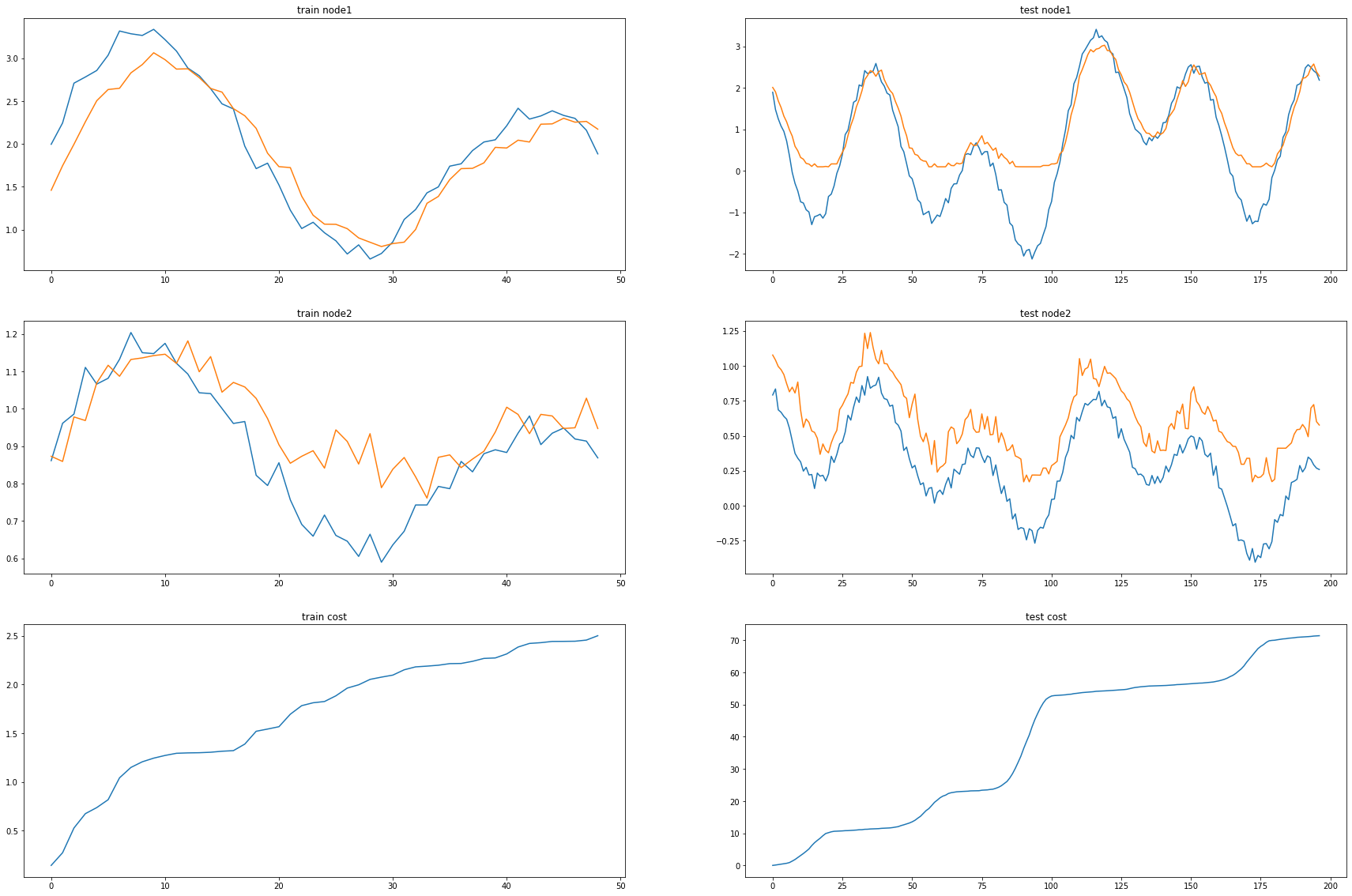
TGCN(Done)
TGCN?Init signature: TGCN( in_channels: int, out_channels: int, improved: bool = False, cached: bool = False, add_self_loops: bool = True, ) Docstring: An implementation of the Temporal Graph Convolutional Gated Recurrent Cell. For details see this paper: `"T-GCN: A Temporal Graph ConvolutionalNetwork for Traffic Prediction." <https://arxiv.org/abs/1811.05320>`_ Args: in_channels (int): Number of input features. out_channels (int): Number of output features. improved (bool): Stronger self loops. Default is False. cached (bool): Caching the message weights. Default is False. add_self_loops (bool): Adding self-loops for smoothing. Default is True. Init docstring: Initializes internal Module state, shared by both nn.Module and ScriptModule. File: ~/anaconda3/envs/temp_csy/lib/python3.8/site-packages/torch_geometric_temporal/nn/recurrent/temporalgcn.py Type: type Subclasses:
try:
from tqdm import tqdm
except ImportError:
def tqdm(iterable):
return iterable# import torch
# import torch.nn.functional as F
from torch_geometric_temporal.nn.recurrent import TGCN
# from torch_geometric_temporal.dataset import ChickenpoxDatasetLoader
from torch_geometric_temporal.signal import temporal_signal_split
# loader = ChickenpoxDatasetLoader()
dataset = loader.get_dataset(lags=4)
train_dataset, test_dataset = temporal_signal_split(dataset, train_ratio=0.2)class RecurrentGCN(torch.nn.Module):
def __init__(self, node_features):
super(RecurrentGCN, self).__init__()
self.recurrent = TGCN(node_features, 8)
self.linear = torch.nn.Linear(8, 1)
def forward(self, x, edge_index, edge_weight, prev_hidden_state):
h = self.recurrent(x, edge_index, edge_weight, prev_hidden_state)
y = F.relu(h)
y = self.linear(y)
return y, hmodel = RecurrentGCN(node_features = 4)
optimizer = torch.optim.Adam(model.parameters(), lr=0.01)
model.train()
for epoch in tqdm(range(50)):
cost = 0
hidden_state = None
_b=[]
_d=[]
for time, snapshot in enumerate(train_dataset):
y_hat, hidden_state = model(snapshot.x, snapshot.edge_index, snapshot.edge_attr,hidden_state)
y_hat = y_hat.reshape(-1)
cost = cost + torch.mean((y_hat-snapshot.y)**2)
_b.append(y_hat)
_d.append(cost)
cost = cost / (time+1)
cost.backward()
optimizer.step()
optimizer.zero_grad()100%|██████████| 50/50 [00:06<00:00, 8.10it/s]model.eval()
cost = 0
hidden_state = None
_a=[]
_a1=[]
for time, snapshot in enumerate(test_dataset):
y_hat, hidden_state = model(snapshot.x, snapshot.edge_index, snapshot.edge_attr, hidden_state)
y_hat = y_hat.reshape(-1)
cost = cost + torch.mean((y_hat-snapshot.y)**2)
_a.append(y_hat)
_a1.append(cost)
cost = cost / (time+1)
cost = cost.item()
print("MSE: {:.4f}".format(cost))MSE: 0.8115_e = [_d[i].detach() for i in range(len(_d))]_c = [_a1[i].detach() for i in range(len(_a1))]fig, (( ax1,ax2),(ax3,ax4),(ax5,ax6)) = plt.subplots(3,2,figsize=(30,20))
ax1.set_title('train node1')
ax1.plot([train_dataset.targets[i][0] for i in range(train_dataset.snapshot_count)])
ax1.plot(torch.tensor([_b[i].detach()[0] for i in range(train_dataset.snapshot_count)]))
ax2.set_title('test node1')
ax2.plot([test_dataset.targets[i][0] for i in range(test_dataset.snapshot_count)])
ax2.plot(torch.tensor([_a[i].detach()[0] for i in range(test_dataset.snapshot_count)]))
ax3.set_title('train node2')
ax3.plot([train_dataset.targets[i][1] for i in range(train_dataset.snapshot_count)])
ax3.plot(torch.tensor([_b[i].detach()[1] for i in range(train_dataset.snapshot_count)]))
ax4.set_title('test node2')
ax4.plot([test_dataset.targets[i][1] for i in range(test_dataset.snapshot_count)])
ax4.plot(torch.tensor([_a[i].detach()[1] for i in range(test_dataset.snapshot_count)]))
ax5.set_title('train cost')
ax5.plot(_e)
ax6.set_title('test cost')
ax6.plot(_c)